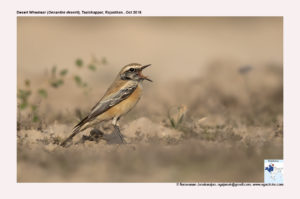Desert Wheatear

Desert Wheatear Oenanthe deserti
Etymology:
- Oenanthe : Greek word oinanthe – unidentified bird mentioned by Aristotle
- Deserti : Latin for “Desert”
Vernacular Name: Guj: Rann piddo, Ranapiddo, Mar: Rangoja
Distribution in India: Resident of Himalayas.
Description: Size of 14–15 cm; wt. of 15–34 g. The male of nominate race in breeding plumage is sandy-brown from crown to upper back, with white supercilium and scapulars, black face through eye to throat and neck side joining black of wings. It has white to buffish-white lower back, rump and very bases of outer tail, rest of tail is black. The underparts are creamy-white with buff tinges on breast and flanks. The undersides of flight-feathers are whitish, underwing-coverts are black; bill and legs are black. The Non-breeding male has hoary face and obscured scapulars. The breeding female is colder-toned, with pale scapulars and tail pattern as male. The non-breeding female is similar but duller and plainer. The juvenile is like non-breeding female, but buff-spotted above, finely scaled and brownish on breast; first-winter male is like breeding female, but with traces of blackish on ear-coverts and neck side.
Habitat: It is found in dry steppes and desert edge with little vegetation, dry sparsely bushed riverbeds, wadis, ruins and stony and gravel flatlands. It isfound up to 5100 m
Food habits: It eats invertebratesand seeds. The animal food includes adult and larval beetles, adult and larval lepidopterans, adult and larval flies, ants and bees, grasshoppers and locusts, cockroaches and mantises, bugs, earwigs, termites, dragonflies, spiders, woodlice, myriapods and worms. The plant food includes small seeds. It feeds on ground with bound-and-grab manoeuvres; also scans from perch often in winter a piece of stubble, and sallies either to ground or after flying insects. It also uses hovering as hunting technique when low wind available..
Breeding habits : They breed in Feb–Jun in Morocco and mid-Mar to end May in Algeria and Tunisia; May–Jul in Egypt; early Apr to mid-Jul in Israel; from May in Pakistan and Pamirs; Apr–Jun in C Asia; late Apr to mid-Aug in Mongolia and mid-May in Dzungarian Gobi. The nest is bulky, made of grass and root fibers, lined with finer grass, wool, hair or feathers, placed in hole in roadside or riverbank, rock face, wall, bridge or other building, under stone, bush or pile of stones, amid exposed roots or down old rodent burrow. They lay a clutch of 3–6 eggs. The incubation period is 13–14 days; nestling period is 15–18 days. The post-fledging dependence on parents is up to 3 weeks.